Monitoring Land Surface Temperature Change with Landsat Images during Dry Seasons in Bac Binh, Vietnam
Abstract
1. Introduction
2. Study Area and Data
2.1. Study Area
2.2. Data
3. Methodology
3.1. Extract the Brightness Temperature Value ()
3.2. Extract of LSE Value
3.3. Extract of LST from MODIS Images and Comparison with Landsat-Derived LST
4. Results
4.1. Land-Cover Change
4.2. LST Results and Trends
4.3. Comparison of Landsat LST, MODIS LST and Air Temperature (AT) In-Situ Measurements
4.4. Correlation between LST and Land-Cover
5. Discussion
6. Conclusions
Author Contributions
Funding
Acknowledgments
Conflicts of Interest
References
- Masson-Delmotte, T.; Zhai, P.; Pörtner, H.; Roberts, D.; Skea, J.; Shukla, P.; Pirani, A.; Moufouma-Okia, W.; Péan, C.; Pidcock, R. IPCC: Summary for Policymakers. In Global warming of 1.5 C. An IPCC Special Report on the Impacts of Global Warming of 1.5 °C above Pre-Industrial Levels and Related Global Greenhouse Gas Emission Pathways, in the Context of Strengthening the Global. 2018. Available online: https://www.ipcc.ch/sr15/chapter/spm/ (accessed on 6 October 2018).
- Solomon, S.; Qin, D.; Manning, M.; Chen, Z.; Marquis, M.; Averyt, K.; Tignor, M.; Miller, H. IPCC Fourth Assessment Report (AR4). Available online: https://www.ipcc.ch/report/ar4/syr/ (accessed on 4 January 2007).
- Bangalore, M.; Smith, A.; Veldkamp, T. Exposure to floods, climate change, and poverty in Vietnam. Econ. Disasters Clim. Change 2018. [Google Scholar] [CrossRef]
- Tien Thanh, N.; Dutto Aldo Remo, L. Projected changes of precipitation idf curves for short duration under climate change in central Vietnam. Hydrology 2018, 5, 33. [Google Scholar] [CrossRef]
- Du, T.L.T.; Bui, D.D.; Nguyen, M.D.; Lee, H. Satellite-Based, Multi-Indices for Evaluation of Agricultural Droughts in a Highly Dynamic Tropical Catchment, Central Vietnam. Water 2018, 10, 659. [Google Scholar] [CrossRef]
- Opitz-Stapleton, S.; Sabbag, L.; Hawley, K.; Tran, P.; Hoang, L.; Nguyen, P.H. Heat index trends and climate change implications for occupational heat exposure in Da Nang, Vietnam. Clim. Serv. 2016, 2, 41–51. [Google Scholar] [CrossRef]
- Hulley, G.C.; Ghent, D.; Göttsche, F.M.; Guillevic, P.C.; Mildrexler, D.J.; Coll, C. Land Surface Temperature. In Taking the Temperature of the Earth; Elsevier: Amsterdam, The Netherlands, 2019; pp. 57–127. [Google Scholar] [CrossRef]
- Schneider, P.; Hook, S.J. Space observations of inland water bodies show rapid surface warming since 1985. Geophys. Res. Lett. 2010, 37. [Google Scholar] [CrossRef]
- General, A. Transforming Our World: The 2030 Agenda for Sustainable Development; UN: New York, NY, USA, 2015. [Google Scholar]
- Ferreira, L.S.; Duarte, D.H.S. Exploring the relationship between urban form, land surface temperature and vegetation indices in a subtropical megacity. Urban. Clim. 2019, 27, 105–123. [Google Scholar] [CrossRef]
- Sayão, V.M.; Demattê, J.A.M.; Bedin, L.G.; Nanni, M.R.; Rizzo, R. Satellite land surface temperature and reflectance related with soil attributes. Geoderma 2018, 325, 125–140. [Google Scholar] [CrossRef]
- Sobrino, J.A.; Jiménez-Muñoz, J.C.; Paolini, L. Land surface temperature retrieval from LANDSAT TM 5. Remote Sens. Environ. 2004, 90, 434–440. [Google Scholar] [CrossRef]
- Zhang, Z.M.; He, G.J. Generation of Landsat surface temperature product for China, 2000–2010. Int. J. Remote Sens. 2013, 34, 7369–7375. [Google Scholar] [CrossRef]
- Simwanda, M.; Ranagalage, M.; Estoque, R.C.; Murayama, Y. Spatial analysis of surface urban heat islands in four rapidly growing African Cities. Remote Sens. 2019, 11, 1645. [Google Scholar] [CrossRef]
- Shi, Y.; Zhang, Y. Remote sensing retrieval of urban land surface temperature in hot-humid region. Urban. Clim. 2018, 24, 299–310. [Google Scholar] [CrossRef]
- Fu, P.; Weng, Q. Temporal dynamics of land surface temperature from Landsat TIR time series images. IEEE Geosci. Remote Sens. Lett. 2015, 12, 2175–2179. [Google Scholar] [CrossRef]
- Athick, A.M.A.; Shankar, K.; Naqvi, H.R. Data on time series analysis of land surface temperature variation in response to vegetation indices in twelve wereda of Ethiopia using mono window, split window algorithm and spectral radiance model. Data Brief 2019, 27, 104773. [Google Scholar] [CrossRef] [PubMed]
- Thanh Hoan, N.; Liou, Y.-A.; Nguyen, K.-A.; Sharma, R.; Tran, D.-P.; Liou, C.-L.; Cham, D. Assessing the Effects of Land-Use Types in Surface Urban Heat Islands for Developing Comfortable Living in Hanoi City. Remote Sens. 2018, 10, 1965. [Google Scholar] [CrossRef]
- Son, N.-T.; Thanh, B.-X. Decadal assessment of urban sprawl and its effects on local temperature using Landsat data in Cantho city, Vietnam. Sustain. Cities Soc. 2018, 36, 81–91. [Google Scholar] [CrossRef]
- Son, N.T.; Chen, C.F.; Chen, C.R.; Chang, L.Y.; Minh, V.Q. Monitoring agricultural drought in the Lower Mekong Basin using MODIS NDVI and land surface temperature data. Int. J. Appl. Earth Obs. Geoinf. 2012, 18, 417–427. [Google Scholar] [CrossRef]
- Wang, C.; Myint, S.; Wang, Z.; Song, J. Spatio-Temporal Modeling of the Urban Heat Island in the Phoenix Metropolitan Area: Land Use Change Implications. Remote Sens. 2016, 8, 185. [Google Scholar] [CrossRef]
- Cao, X.; Feng, Y.; Wang, J. Remote sensing monitoring the spatio-temporal changes of aridification in the Mongolian Plateau based on the general Ts-NDVI space, 1981–2012. J. Earth Syst. Sci. 2017, 126. [Google Scholar] [CrossRef]
- Jiang, M.; Lin, Y. Desertification in the south Junggar Basin, 2000–2009: Part I. Spatial analysis and indicator retrieval. Adv. Space Res. 2018, 62, 1–15. [Google Scholar] [CrossRef]
- General_Statistics_Office. Completed Results of the 2019 Viet Nam Population and Housing Census; General Statistics Office of Vietnam: Hanoi, Vietnam, 2020; p. 840. [Google Scholar]
- MONRE. Climate Change and Sea Level Rise Scenarios for Vietnam. Available online: https://www.preventionweb.net/files/11348_ClimateChangeSeaLevelScenariosforVi.pdf (accessed on 12 June 2019).
- Binh Thuan Statistical Office. Socio-Economic Situation in the First 6 Months of 2019. Available online: http://cucthongke.vn/xem-tin-tuc.aspx?idp=1&idc=23662 (accessed on 12 June 2019).
- Committee for Ethnic Minority affairs Web Portal The Inspection Depatrment of Central Committee Work in Bac Binh District Party Committee. Available online: http://www.cema.gov.vn/uy-ban-dan-toc-voi-dia-phuong/doan-kiem-tra-ban-chi-dao-trung-uong-lam-viec-voi-huyen-uy-bac-binh-binh-thuan-ve-cong-tac-dan-toc.htm (accessed on 12 April 2019).
- United States Geological Survey. Available online: https://earthexplorer.usgs.gov/ (accessed on 12 April 2019).
- Roy, D.P.; Wulder, M.A.; Loveland, T.R.; Woodcock, C.E.; Allen, R.G.; Anderson, M.C.; Helder, D.; Irons, J.R.; Johnson, D.M.; Kennedy, R.; et al. Landsat-8: Science and product vision for terrestrial global change research. Remote Sens. Environ. 2014, 145, 154–172. [Google Scholar] [CrossRef]
- Claverie, M.; Vermote, E.F.; Franch, B.; Masek, J.G. Evaluation of the Landsat-5 TM and Landsat-7 ETM+ surface reflectance products. Remote Sens. Environ. 2015, 169, 390–403. [Google Scholar] [CrossRef]
- Kilic, A.; Allen, R.; Trezza, R.; Ratcliffe, I.; Kamble, B.; Robison, C.; Ozturk, D. Sensitivity of evapotranspiration retrievals from the METRIC processing algorithm to improved radiometric resolution of Landsat 8 thermal data and to calibration bias in Landsat 7 and 8 surface temperature. Remote Sens. Environ. 2016, 185, 198–209. [Google Scholar] [CrossRef]
- Ruiz-Verdú, A.; Jiménez, J.C.; Lazzaro, X.; Tenjo, C.; Delegido, J.; Pereira, M.; Sobrino, J.A.; Moreno, J. Comparison of modis and landsat-8 retrievals of chlorophyll-a and water temperature over Lake Titicaca. In Proceedings of the 2016 IEEE International Geoscience and Remote Sensing Symposium (IGARSS), Beijing, China, 10–15 July 2016. [Google Scholar]
- Al-Hamdan, M.; Quattrochi, D.; Bounoua, L.; Lachir, A.; Zhang, P. Using Landsat, MODIS, and a Biophysical Model to Evaluate LST in Urban Centers. Remote Sens. 2016, 8, 952. [Google Scholar] [CrossRef]
- Bendib, A.; Dridi, H.; Kalla, M.I. Contribution of Landsat 8 data for the estimation of land surface temperature in Batna city, Eastern Algeria. Geocarto Int. 2017, 32, 503–513. [Google Scholar] [CrossRef]
- Li, B.; Ti, C.; Zhao, Y.; Yan, X. Estimating Soil Moisture with Landsat Data and Its Application in Extracting the Spatial Distribution of Winter Flooded Paddies. Remote Sens. 2016, 8, 38. [Google Scholar] [CrossRef]
- El-Hattab, M.; Amany, S.M.; Lamia, G.E. Monitoring and assessment of urban heat islands over the Southern region of Cairo Governorate, Egypt. Egypt. J. Remote Sens. Space Sci. 2018, 21, 311–323. [Google Scholar] [CrossRef]
- Nguyen, T.; Lin, T.-H.; Chan, H.-P. The Environmental Effects of Urban Development in Hanoi, Vietnam from Satellite and Meteorological Observations from 1999–2016. Sustainability 2019, 11, 1768. [Google Scholar] [CrossRef]
- Valor, E.; Caselles, V. Mapping land surface emissivity from NDVI. Application to European African and South American areas. Remote Sens. Environ. 1996, 57, 167–184. [Google Scholar] [CrossRef]
- Wang, S.; Ma, Q.; Ding, H.; Liang, H. Detection of urban expansion and land surface temperature change using multi-temporal landsat images. Resour. Conserv. Recycl. 2018, 128, 526–534. [Google Scholar] [CrossRef]
- Sejati, A.W.; Buchori, I.; Rudiarto, I. The spatio-temporal trends of urban growth and surface urban heat islands over two decades in the Semarang Metropolitan Region. Sustain. Cities Soc. 2019, 46. [Google Scholar] [CrossRef]
- Sun, Y.; Gao, C.; Li, J.; Wang, R.; Liu, J. Quantifying the Effects of Urban Form on Land Surface Temperature in Subtropical High-Density Urban Areas Using Machine Learning. Remote Sens. 2019, 11, 959. [Google Scholar] [CrossRef]
- Chatterjee, R.S.; Singh, N.; Thapa, S.; Sharma, D.; Kumar, D. Retrieval of land surface temperature (LST) from landsat TM6 and TIRS data by single channel radiative transfer algorithm using satellite and ground-based inputs. Int. J. Appl. Earth Obs. Geoinf. 2017, 58, 264–277. [Google Scholar] [CrossRef]
- Peng, J.; Ma, J.; Liu, Q.; Liu, Y.; Hu, Y.; Li, Y.; Yue, Y. Spatial-temporal change of land surface temperature across 285 cities in China: An urban-rural contrast perspective. Sci. Total Environ. 2018, 635, 487–497. [Google Scholar] [CrossRef] [PubMed]
- Zhang, Y.; Sun, L. Spatial-temporal impacts of urban land use land cover on land surface temperature: Case studies of two Canadian urban areas. Int. J. Appl. Earth Obs. Geoinf. 2019, 75, 171–181. [Google Scholar] [CrossRef]
- Chander, G.; Markham, B. Revised Landsat-5 TM radiometric calibration procedures and postcalibration dynamic ranges. IEEE Trans. Geosci. Remote Sens. 2003, 41, 2674–2677. [Google Scholar] [CrossRef]
- United States Geological Survey. Landsat 7 (L7) Data Users Handbook. Available online: https://www.usgs.gov/media/files/landsat-7-data-users-handbook (accessed on 5 December 2019).
- Zanter, K. Landsat 8 (L8) Data Users Handbook; Landsat Science Official Website, US Geological Survey: Reston, VA, USA, 2016. [Google Scholar]
- Van De Griend, A.A.; Owe, M. On the relationship between thermal emissivity and the normalized difference vegetation index for natural surfaces. Int. J. Remote Sens. 1993, 14, 1119–1131. [Google Scholar] [CrossRef]
- Wang, H.; Li, X.B.; Long, H.L.; Xu, X.; Bao, Y. Monitoring the effects of land use and cover type changes on soil moisture using remote-sensing data: A case study in China’s Yongding River basin. Catena 2010, 82, 135–145. [Google Scholar] [CrossRef]
- Bonafoni, S.; Anniballe, R.; Gioli, B.; Toscano, P. Downscaling Landsat Land Surface Temperature over the urban area of Florence. Eur. J. Remote Sens. 2016, 49, 553–569. [Google Scholar] [CrossRef]
- Sobrino, J.A.; Jiménez-Muñoz, J.C.; Sòria, G.; Romaguera, M.; Guanter, L.; Moreno, J.; Plaza, A.; Martínez, P. Land surface emissivity retrieval from different VNIR and TIR sensors. IEEE Trans. Geosci. Remote Sens. 2008, 48, 316–327. [Google Scholar] [CrossRef]
- Carlson, T.N.; Riziley, D.A. On the Relation between NDVI, Fractional Vegetation Cover, and Leaf Area Index. Remote Sens. Environ. 1997, 62, 241–252. [Google Scholar] [CrossRef]
- Zhao, S.; Cong, D.; He, K.; Yang, H.; Qin, Z. Spatial-Temporal Variation of Drought in China from 1982 to 2010 Based on a modified Temperature Vegetation Drought Index (mTVDI). Sci. Rep. 2017, 7, 17473. [Google Scholar] [CrossRef] [PubMed]
- Madanian, M.; Soffianian, A.R.; Soltani Koupai, S.; Pourmanafi, S.; Momeni, M. The study of thermal pattern changes using Landsat-derived land surface temperature in the central part of Isfahan province. Sustain. Cities Soc. 2018, 39, 650–661. [Google Scholar] [CrossRef]
- Guanter, L.; Del Carmen González-Sanpedro, M.; Moreno, J. A method for the atmospheric correction of ENVISAT/MERIS data over land targets. Int. J. Remote Sens. 2010, 28, 709–728. [Google Scholar] [CrossRef]
- Wan, Z. MODIS_Collection6_LST_Products_UsersGuide; ERI, University of California: Santa Barbara, CA, USA, 2013. [Google Scholar]
- Jia, X.; Richards, J.A. Efficient maximum likelihood classification for imaging spectrometer data sets. IEEE Trans. Geosci. Remote Sens. 1994, 32, 274–281. [Google Scholar] [CrossRef]
- Reis, S. Analyzing land use/land cover changes using remote sensing and GIS in Rize, North-East Turkey. Sensors 2008, 8, 6188–6202. [Google Scholar] [CrossRef]
- Li, C.; Wang, J.; Wang, L.; Hu, L.; Gong, P. Comparison of Classification Algorithms and Training Sample Sizes in Urban Land Classification with Landsat Thematic Mapper Imagery. Remote Sens. 2014, 6, 964–983. [Google Scholar] [CrossRef]
- Jensen, J.R. Introductory Digital Image Processing: A Remote Sensing Perspective; Prentice-Hall Inc.: Upper Saddle River, NJ, USA; Michigan University: Ann Arbor, MI, USA, 1996. [Google Scholar]
- Tan, Z.; Liu, S.; Wylie, B.K.; Jenkerson, C.B.; Oeding, J.; Rover, J.; Young, C. MODIS-informed greenness responses to daytime land surface temperature fluctuations and wildfire disturbances in the Alaskan Yukon River Basin. Int. J. Remote Sens. 2012, 34, 2187–2199. [Google Scholar] [CrossRef]
- Horowitz, F.G. MODIS Daily Land Surface Temperature Estimates in Google Earth Engine as an Aid in Geothermal Energy Siting. In Proceedings of the Proceedings World Geothermal Congress, Melbourne, Australia, 16–24 April 2015. [Google Scholar]
- Menne, M.J.; Durre, I.; Korzeniewski, B.; McNeal, S.; Thomas, K.; Yin, X.; Anthony, S.; Ray, R.; Vose, R.S.; Gleason, B.E. Global historical climatology network-daily (GHCN-Daily), Version 3. Phan Thiet. NOAA National Climatic Data Center. NOAA Natl. Clim. Data Cent. 2012. [Google Scholar] [CrossRef]
- Foody, G.M. Explaining the unsuitability of the kappa coefficient in the assessment and comparison of the accuracy of thematic maps obtained by image classification. Remote Sens. Environ. 2020, 239, 111630. [Google Scholar] [CrossRef]
- Rwanga, S.S.; Ndambuki, J.M. Accuracy assessment of land use/land cover classification using remote sensing and GIS. Int. J. Geosci. 2017, 8, 611–622. [Google Scholar] [CrossRef]
- ThienNhien.Net. Thousands of Precious Wood Blocks in Song Luy Forest Have Been Lowered. Available online: https://www.thiennhien.net/2017/12/26/hang-ngan-khoi-go-quy-o-rung-song-luy-bi-triet-ha/ (accessed on 26 December 2017).
- Vietnam Agency. Binh Thuan Drought. Available online: https://dantocmiennui.vn/cuoc-chien-chong-sa-mac-hoa-o-binh-thuan/232632.html (accessed on 12 June 2019).
- Land Use in Bac Binh Distric. 2019. Available online: https://stnmt.binhthuan.gov.vn/mDefault.aspx?sid=1326&pageid=3601&catid=65791&id=566154&catname=dat-dai&title=ke-hoach-su-dung-dat-nam-2019-huyen-bac-binh (accessed on 18 December 2019).
- MARD. Decision on Promulgating the Operating Process for Regulating Ca Giay Lake in Binh Thuan Province. Available online: https://thuvienphapluat.vn/van-ban/xay-dung-do-thi/Quyet-dinh-52-2005-QD-BNN-Quy-trinh-van-hanh-dieu-tiet-ho-chua-nuoc-Ca-Giay-tinh-Binh-Thuan-4378.aspx (accessed on 24 August 2005).
- Phan, T.N.; Kappas, M.; Nguyen, K.T.; Tran, T.P.; Tran, Q.V.; Emam, A.R. Evaluation of MODIS land surface temperature products for daily air surface temperature estimation in northwest Vietnam.pdf. Int. J. Remote Sens. 2019. [Google Scholar] [CrossRef]
- Fonseka, H.P.U.; Zhang, H.; Sun, Y.; Su, H.; Lin, H.; Lin, Y. Urbanization and Its Impacts on Land Surface Temperature in Colombo Metropolitan Area, Sri Lanka, from 1988 to 2016. Remote Sens. 2019, 11, 957. [Google Scholar] [CrossRef]
- Lai, S.; Leone, F.; Zoppi, C.J.S. Spatial Distribution of Surface Temperature and Land Cover: A Study Concerning Sardinia, Italy. Sustainability 2020, 12, 3186. [Google Scholar] [CrossRef]
- Vietnam Agency. Titanium Exploitation in Binh Thuan. Available online: https://baotintuc.vn/kinh-te/quy-hoach-khai-thac-su-dung-titan-bai-2-loi-bat-cap-hai-20190515122346606.htm (accessed on 15 May 2019).
- MONRE. To Definitely Handle the Situation of Illegal Mineral Exploitation. Available online: http://www.monre.gov.vn/Pages/bac-binh-%E2%80%93-binh-thuan--xu-ly-dut-diem-tinh-trang-khai-thac-khoang-san-trai-phep.aspx (accessed on 12 February 2020).
- Vietnam Agency. Bac Binh District Focuses on Rectifying Illegal Mineral Exploitation Activities in the Area. Available online: https://www.binhthuan.gov.vn/4/469/65117/567281/tin-dia-phuong/huyen-bac-binh-tap-trung-chan-chinh-hoat-dong-khai-thac-khoang-san-trai-phep-tren-dia-ban.aspx (accessed on 20 January 2020).
- Vietnam Agency. Bac Binh Applies High Technology in Agricultural Production. Available online: https://dantocmiennui.vn/kinh-nghiem-lam-an/bac-binh-ung-dung-cong-nghe-cao-trong-san-xuat-nong-nghiep/282631.html (accessed on 23 January 2020).
- Brown, M.E.; Pinzón, J.E.; Didan, K.; Morisette, J.T.; Tucker, C.J. Evaluation of the consistency of long-term NDVI time series derived from AVHRR, SPOT-vegetation, SeaWiFS, MODIS, and Landsat ETM+ sensors. IEEE Trans. Geosci. Remote Sens. 2006, 44, 1787–1793. [Google Scholar] [CrossRef]
- Weng, Q.; Fu, P.; Gao, F. Generating daily land surface temperature at Landsat resolution by fusing Landsat and MODIS data. Remote Sens. Environ. 2014, 145, 55–67. [Google Scholar] [CrossRef]
- Good, E.J.; Ghent, D.J.; Bulgin, C.E.; Remedios, J.J. A spatiotemporal analysis of the relationship between near-surface air temperature and satellite land surface temperatures using 17 years of data from the ATSR series. J. Geophys. Res. Atmos. 2017, 122, 9185–9210. [Google Scholar] [CrossRef]
- Gallo, K.; Hale, R.; Tarpley, D.; Yu, Y. Evaluation of the relationship between air and land surface temperature under clear-and cloudy-sky conditions. J. Appl. Meteorol. Climatol. 2011, 50, 767–775. [Google Scholar] [CrossRef]
- Tran, H.T.; Campbell, J.B.; Tran, T.D.; Tran, H.T. Monitoring drought vulnerability using multispectral indices observed from sequential remote sensing (Case Study: Tuy Phong, Binh Thuan, Vietnam). Geosci. Remote Sens. 2017, 54, 167–184. [Google Scholar] [CrossRef]
- Islam, S.; Ma, M. Geospatial Monitoring of Land Surface Temperature Effects on Vegetation Dynamics in the Southeastern Region of Bangladesh from 2001 to 2016. ISPRS Int. J. Geoinf. 2018, 7, 486. [Google Scholar] [CrossRef]
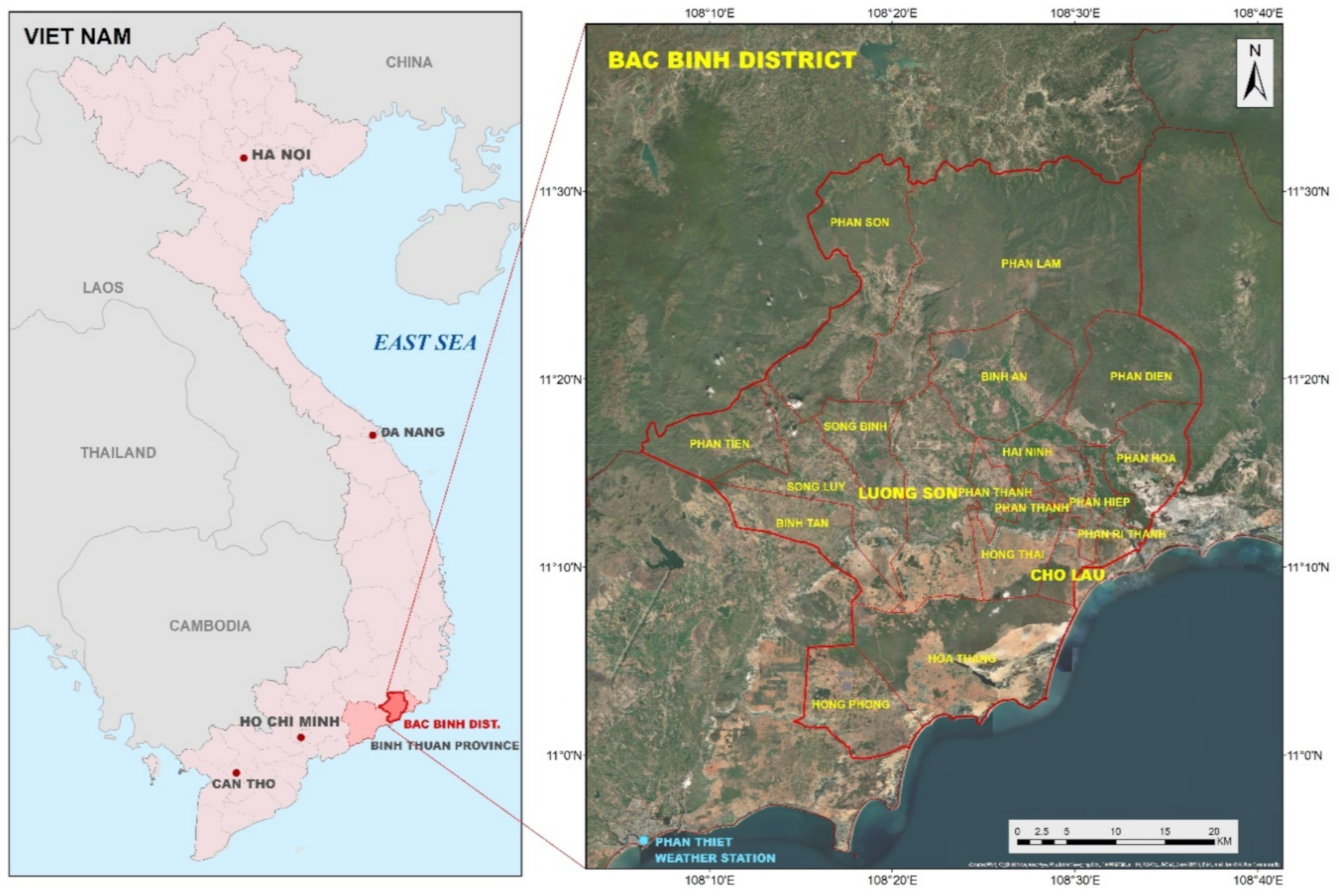

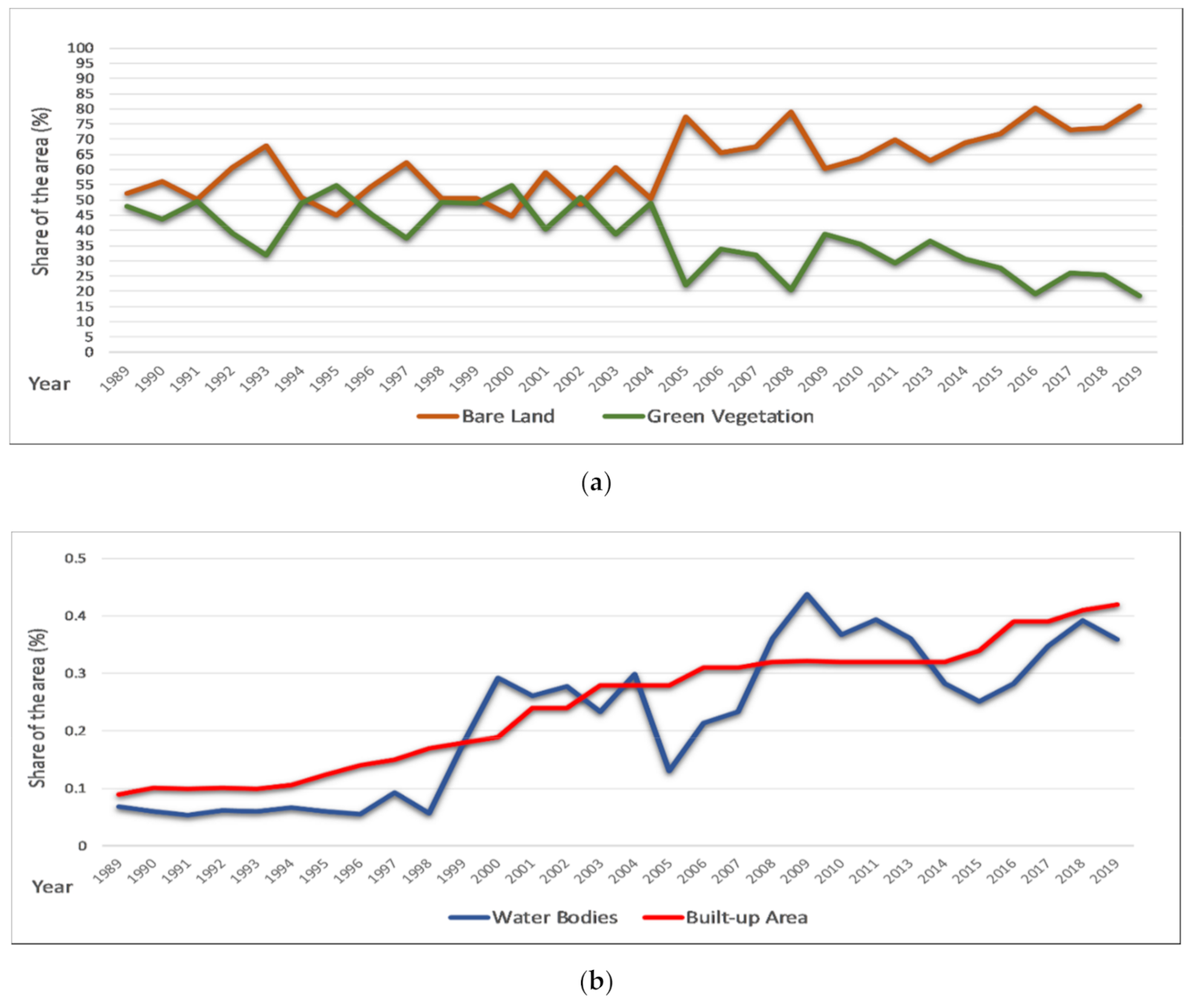

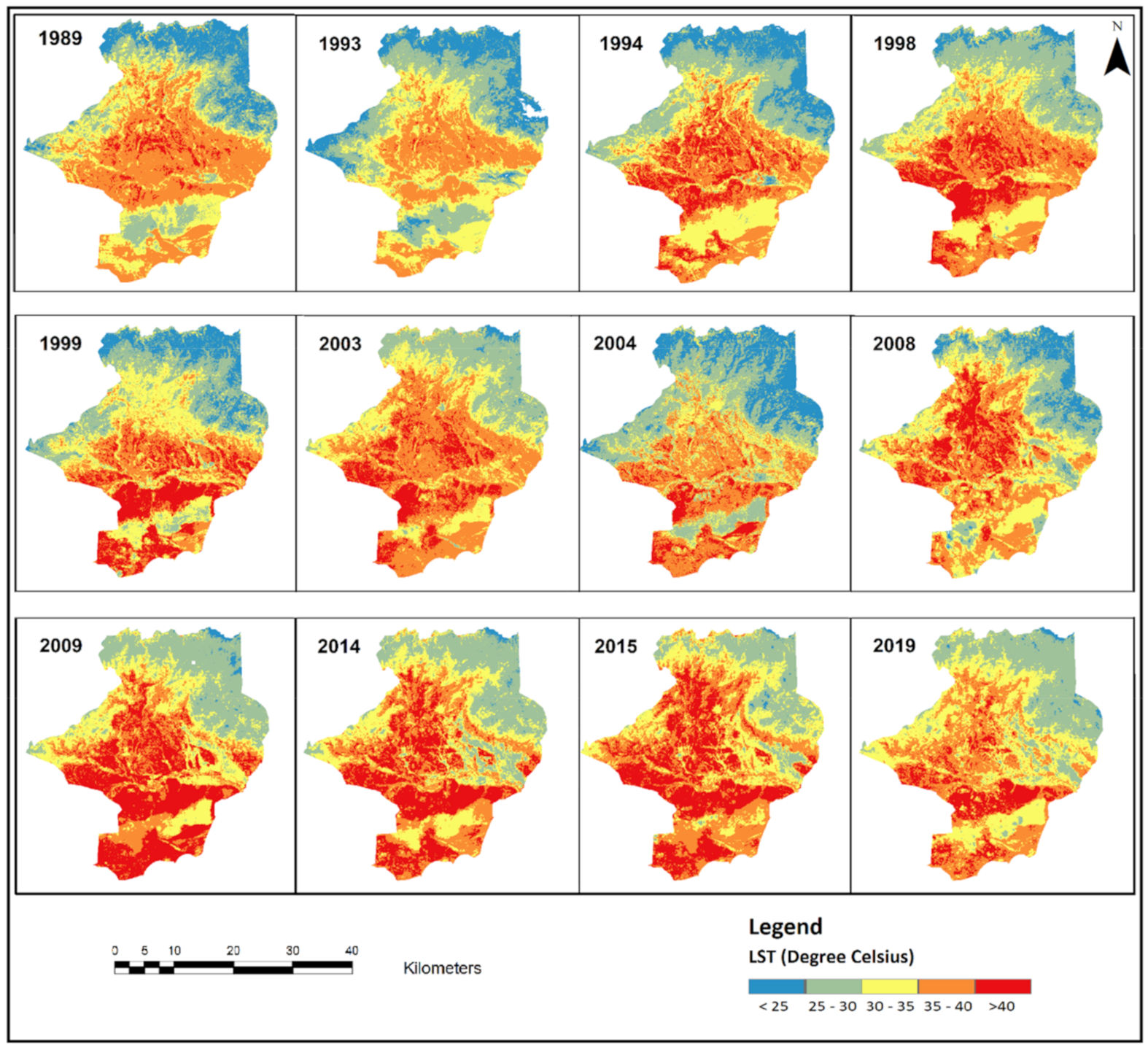



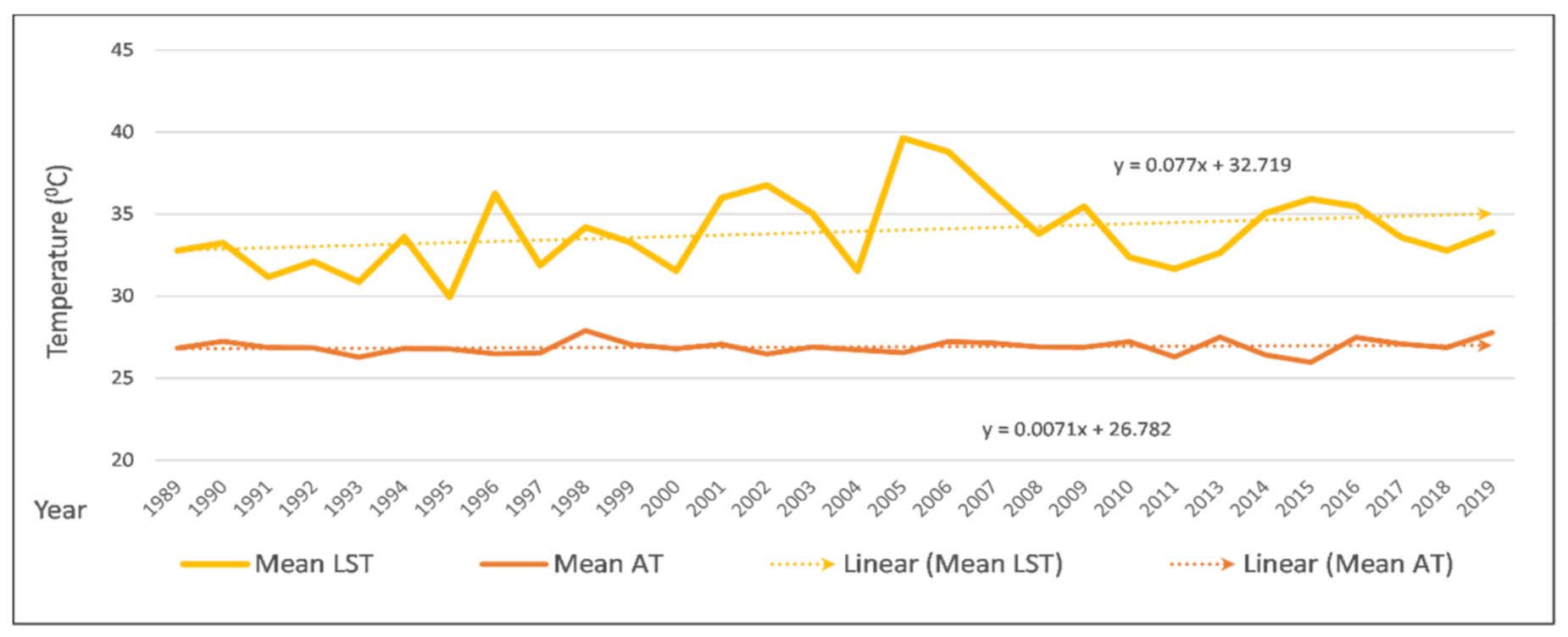
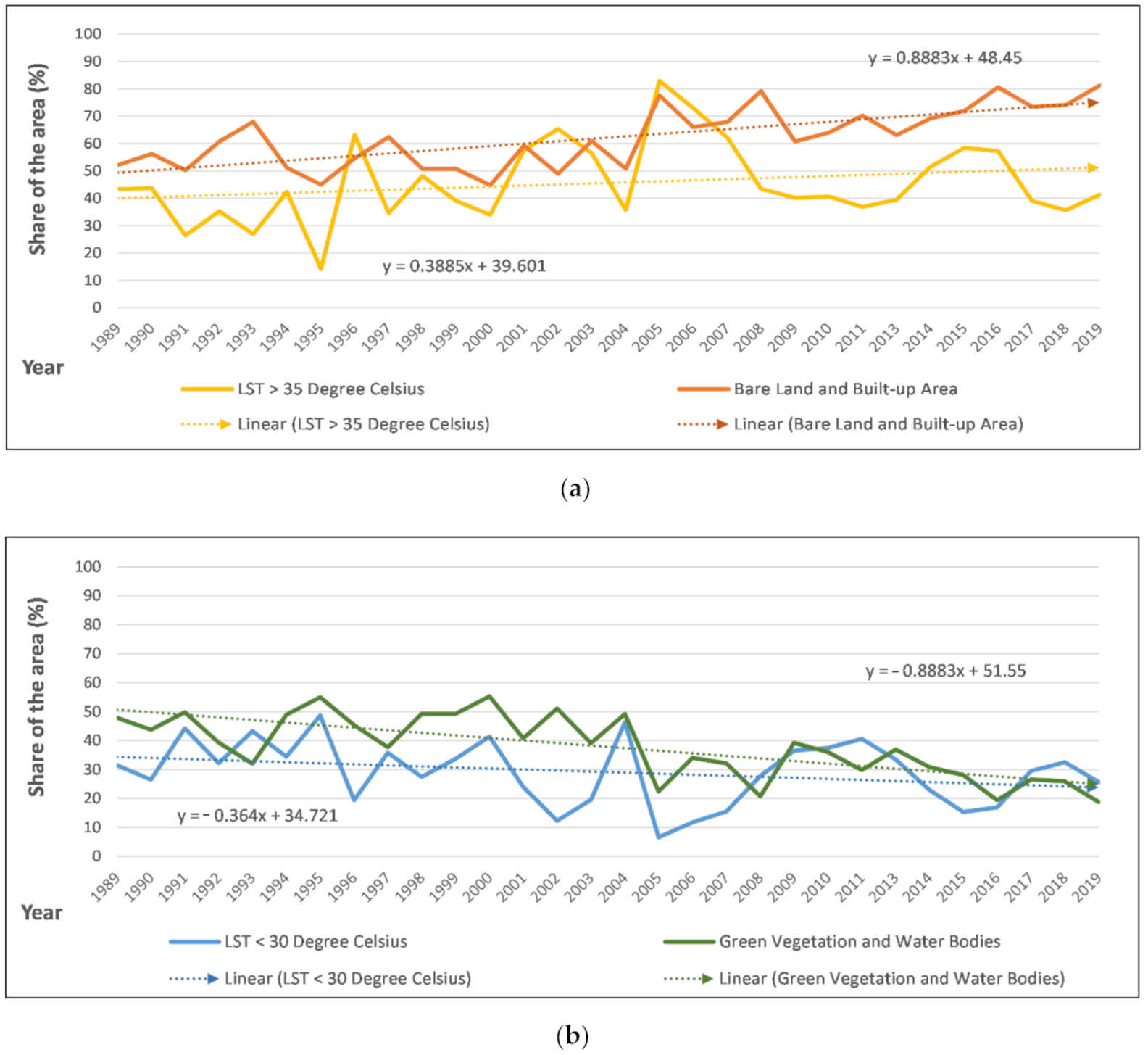
| No | Period | Sensor | No | Period | Sensor | ||||
|---|---|---|---|---|---|---|---|---|---|
| Year | Month | Date | Year | Month | Date | ||||
| 01 | 1989 | 01 | 25 | LandSat TM | 16 | 2004 | 01 | 03 | LandSat TM |
| 1989 | 02 | 01 | LandSat TM | 2004 | 04 | 24 | LandSat TM | ||
| 1989 | 03 | 06 | LandSat TM | ||||||
| 02 | 1989 | 12 | 27 | LandSat TM | 17 | 2005 | 01 | 05 | LandSat TM |
| 1990 | 02 | 13 | LandSat TM | 2005 | 02 | 22 | LandSat TM | ||
| 1990 | 03 | 17 | LandSat TM | 2005 | 03 | 26 | LandSat TM | ||
| 03 | 1990 | 12 | 14 | LandSat TM | 18 | 2006 | 03 | 13 | LandSat TM |
| 1991 | 01 | 31 | LandSat TM | 2006 | 04 | 14 | LandSat TM | ||
| 1991 | 04 | 21 | LandSat TM | ||||||
| 04 | 1991 | 12 | 14 | LandSat TM | 19 | 2007 | 01 | 27 | LandSat TM |
| 1992 | 02 | 03 | LandSat TM | 2007 | 02 | 28 | LandSat TM | ||
| 1992 | 03 | 22 | LandSat TM | 2007 | 04 | 01 | LandSat TM | ||
| 05 | 1992 | 12 | 01 | LandSat TM | 20 | 2008 | 03 | 18 | LandSat TM |
| 1993 | 03 | 09 | LandSat TM | 2008 | 03 | 18 | LandSat TM | ||
| 1993 | 03 | 22 | LandSat TM | 2008 | 04 | 03 | LandSat TM | ||
| 06 | 1994 | 01 | 23 | LandSat TM | 21 | 2009 | 01 | 16 | LandSat TM |
| 1994 | 03 | 12 | LandSat TM | 2009 | 02 | 17 | LandSat TM | ||
| 1994 | 04 | 13 | LandSat TM | 2009 | 03 | 21 | LandSat TM | ||
| 07 | 1994 | 12 | 25 | LandSat TM | 22 | 2009 | 12 | 18 | LandSat TM |
| 1995 | 01 | 10 | LandSat TM | 2010 | 02 | 04 | LandSat TM | ||
| 1995 | 02 | 11 | LandSat TM | 2010 | 02 | 10 | LandSat ETM + | ||
| 08 | 1996 | 01 | 13 | LandSat TM | 23 | 2011 | 01 | 06 | LandSat TM |
| 1996 | 01 | 29 | LandSat TM | 2011 | 02 | 07 | LandSat TM | ||
| 1996 | 03 | 01 | LandSat TM | ||||||
| 09 | 1997 | 01 | 31 | LandSat TM | 24 | 2013 | 04 | 17 | LandSat OLI |
| 1997 | 03 | 04 | LandSat TM | 2013 | 01 | 19 | LandSat ETM + | ||
| 1997 | 04 | 21 | LandSat TM | ||||||
| 10 | 1997 | 12 | 01 | LandSat TM | 25 | 2014 | 01 | 30 | LandSat OLI |
| 1998 | 01 | 02 | LandSat TM | 2014 | 02 | 15 | LandSat OLI | ||
| 1998 | 03 | 23 | LandSat TM | 2014 | 03 | 19 | LandSat OLI | ||
| 11 | 1999 | 02 | 06 | LandSat TM | 26 | 2015 | 02 | 18 | LandSat OLI |
| 1999 | 03 | 10 | LandSat TM | 2015 | 03 | 22 | LandSat OLI | ||
| 2015 | 04 | 07 | LandSat OLI | ||||||
| 12 | 1999 | 12 | 23 | LandSat TM | 27 | 2016 | 01 | 20 | LandSat OLI |
| 2000 | 03 | 28 | LandSat TM | 2016 | 02 | 21 | LandSat OLI | ||
| 2016 | 03 | 08 | LandSat OLI | ||||||
| 13 | 2001 | 01 | 10 | LandSat TM | 28 | 2017 | 02 | 07 | LandSat OLI |
| 2001 | 02 | 27 | LandSat TM | 2017 | 02 | 23 | LandSat OLI | ||
| 2001 | 03 | 31 | LandSat TM | 2017 | 03 | 11 | LandSat OLI | ||
| 14 | 2002 | 01 | 05 | LandSat ETM + | 29 | 2018 | 01 | 25 | LandSat OLI |
| 2002 | 02 | 06 | LandSat ETM + | 2018 | 02 | 16 | LandSat OLI | ||
| 2002 | 03 | 10 | LandSat ETM + | 2018 | 03 | 14 | LandSat OLI | ||
| 15 | 2003 | 01 | 08 | LandSat ETM + | 30 | 2019 | 01 | 28 | LandSat OLI |
| 2003 | 02 | 25 | LandSat ETM + | 2019 | 02 | 13 | LandSat OLI | ||
| 2003 | 03 | 29 | LandSat ETM + | 2019 | 03 | 17 | LandSat OLI | ||
| Year | Bare Land (%) | Green Vegetation (%) | Water Bodies (%) | Built-Up Area (%) | Overall Accuracy (%) | Kappa Coefficient | |
|---|---|---|---|---|---|---|---|
| 2000 | User’s accuracy | 61.01 | 65.47 | 79.56 | 77.97 | 73.36 | 0.63 |
| Producer’s accuracy | 62.07 | 65.47 | 80.74 | 76.03 | |||
| 2010 | User’s accuracy | 63.01 | 64.36 | 80.15 | 78.89 | 73.25 | 0.63 |
| Producer’s accuracy | 67.64 | 62.92 | 81.39 | 75.43 | |||
| 2019 | User’s accuracy | 68.42 | 66.26 | 89.31 | 86.82 | 80.75 | 0.73 |
| Producer’s accuracy | 67.24 | 67.90 | 87.97 | 87.50 |
| Year | Landsat-LST (°C) | MODIS11A2-LST (°C) | Difference (°C) | Year | Landsat-LST (°C) | MODIS11A2-LST (°C) | Difference(°C) |
|---|---|---|---|---|---|---|---|
| 2001 | 35.98 | 35.13 | 0.85 | 2010 | 32.36 | 33.32 | −0.96 |
| 2002 | 36.76 | 36.12 | 0.63 | 2011 | 31.65 | 33.01 | −1.36 |
| 2003 | 35.06 | 36.15 | −1.10 | 2013 | 32.63 | 32.84 | −0.21 |
| 2004 | 31.53 | 32.90 | −1.37 | 2014 | 35.05 | 34.44 | 0.62 |
| 2005 | 39.63 | 38.71 | 0.92 | 2015 | 35.92 | 35.29 | 0.63 |
| 2006 | 38.80 | 38.35 | 0.45 | 2016 | 35.47 | 35.68 | −0.21 |
| 2007 | 36.25 | 36.30 | −0.05 | 2017 | 33.59 | 33.35 | 0.24 |
| 2008 | 33.81 | 35.10 | −1.28 | 2018 | 32.77 | 32.22 | 0.55 |
| 2009 | 35.48 | 34.93 | 0.54 | 2019 | 33.87 | 33.47 | 0.40 |
| No | LST Image | Minimum (°C) | Maximum (°C) | Mean (°C) | Standard Deviation |
|---|---|---|---|---|---|
| 1 | Landsat | 31.53 | 39.63 | 34.81 | 2.29 |
| 2 | MODIS11A2 | 32.22 | 38.71 | 34.85 | 1.85 |
Publisher’s Note: MDPI stays neutral with regard to jurisdictional claims in published maps and institutional affiliations. |
© 2020 by the authors. Licensee MDPI, Basel, Switzerland. This article is an open access article distributed under the terms and conditions of the Creative Commons Attribution (CC BY) license (http://creativecommons.org/licenses/by/4.0/).
Share and Cite
Dang, T.; Yue, P.; Bachofer, F.; Wang, M.; Zhang, M. Monitoring Land Surface Temperature Change with Landsat Images during Dry Seasons in Bac Binh, Vietnam. Remote Sens. 2020, 12, 4067. https://doi.org/10.3390/rs12244067
Dang T, Yue P, Bachofer F, Wang M, Zhang M. Monitoring Land Surface Temperature Change with Landsat Images during Dry Seasons in Bac Binh, Vietnam. Remote Sensing. 2020; 12(24):4067. https://doi.org/10.3390/rs12244067
Chicago/Turabian StyleDang, Thanhtung, Peng Yue, Felix Bachofer, Michael Wang, and Mingda Zhang. 2020. "Monitoring Land Surface Temperature Change with Landsat Images during Dry Seasons in Bac Binh, Vietnam" Remote Sensing 12, no. 24: 4067. https://doi.org/10.3390/rs12244067
APA StyleDang, T., Yue, P., Bachofer, F., Wang, M., & Zhang, M. (2020). Monitoring Land Surface Temperature Change with Landsat Images during Dry Seasons in Bac Binh, Vietnam. Remote Sensing, 12(24), 4067. https://doi.org/10.3390/rs12244067








